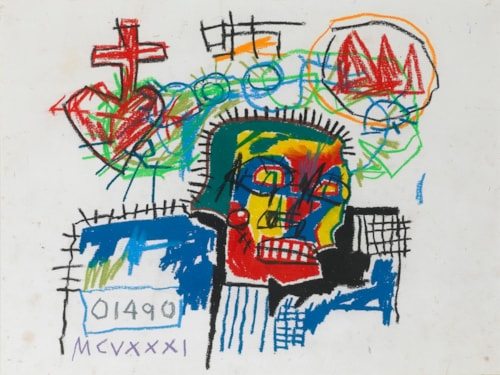
Jean-Michel BASQUIAT
Brooklyn 1960 - New York 1988
Biography
Jean-Michel Basquiat was born in December 1960 to a Puerto Rican mother and a Haitian father, and from an early age displayed a talent for drawing, an activity he maintained throughout his youth. In the late 1970’s he began working as a graffiti artist, and also designed and sold handmade t-shirts and painted postcards. Within a few months Basquiat had begun to make his mark in the downtown art and music world of the day, centred around the East Village, and by the end of 1980 had taken up painting. His first dealer was Annina Nosei, at whose gallery he participated in a group exhibition in 1981. The one-man show that followed a year later was a huge success with critics and collectors, and was followed later that year by shows at the Gagosian Gallery in Los Angeles and with the Zurich dealer Bruno Bischofsberger, who became the artist’s dealer.
Very quickly Basquiat’s paintings, which found their inspiration in Black and urban culture, became highly sought-after. The youngest artist to be included in Documenta VII, held in 1982 in Kassel in Germany, Basquiat was given one-man gallery shows in Rotterdam, Los Angeles, Zurich and Tokyo over the next few months. (He was also one of the youngest artists ever to be included in the Whitney Museum Biennial in 1983.) It was also at around this time he met Andy Warhol, who over the next four years became a close friend, mentor and sometime collaborator. A steady stream of gallery exhibitions in America and Europe, as well as his first museum shows in Edinburgh and London in 1984 and in California in 1985, continued to raise Basquiat’s profile to almost stratospheric heights. At the same time, however, his drug use became more excessive, and his health started to deteriorate. The death of Warhol in 1987 was a serious blow to the young artist, who became more and more reclusive over the coming months. Basquiat died of a heroin overdose in August 1988, at the age of twenty-seven. His artistic career lasted about nine years, and in that time he produced around a thousand paintings.
Basquiat was a compulsive draughtsman, and produced many hundreds of drawings over the course of his brief career. Indeed, the artist may be said to have been at heart a draughtsman, and his paintings, while resonant with vibrant colour, find their embodiment in line. As one scholar has noted, ‘Basquiat understood color like few others and used it with unbridled temerity, but he was essentially a draftsman…In fact, his paintings are drawn as much as painted. Areas of color are scribbled in impatiently, while most everything else in described with quick, confident, linear strokes…If Basquiat had the facility to deploy the power of color, that did not mean that he also needed to spend a lot of time getting it on canvas; he wanted to be drawing.’ The artist also developed a habit of integrating his drawings into his painted work; photocopying them and gluing the sheets onto his canvases, and then painting over and around them. Replete with signs, symbols, words, numbers and codes, Basquiat’s drawings were a fundamental part of his artistic process.
It is arguably in his drawings that the creative intensity of Basquiat’s artistic temperament can best be seen. As the art dealer Enrico Navarra has pointed out, ‘Basquiat’s works on paper, a separate and distinct part of his work, have a very moving spontaneity and deep intimacy. The themes which were dear to him – autobiographical memories, Black heroes, comic book characters, cartoon characters, anatomical plates, graffiti, money, racism, death, etc. – are employed in a manner that is more striking [and] true-to-life in his works on paper.’ The range of references in Basquiat’s drawings, as in his paintings, often included motifs sourced from Greek and Roman, African, Aztec and Hispanic cultures.


